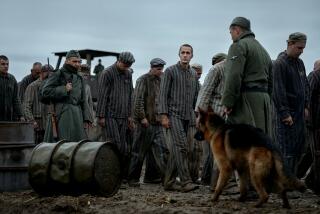Blackouts and Bond Drives: Exhibit Covers WWII Years
- Share via
MONTPELIER, Vt. — On Wednesday afternoons during World War II, the young women of Lyndonville would go down to the church to make 4-by-4 bandages.
“We felt we were doing something for the war effort,” says a note on file at the Vermont Historical Society in Montpelier.
Elsewhere, kids picked milkweed, from which silk was made for parachutes; they collected tin cans in the national “Battle of Scrap,” and they and their families often did without, because everything in the country from butter to gasoline was rationed.
Fifty years later, the Vermont Historical Society has assembled an extraordinary exhibition of propaganda posters, newspapers, photographs, ration stamps--even an entire 1941 living room complete with a 40-inch-high Zenith radio playing the Andrews Sisters.
“Winning The War At Home: Vermont During World War II” is a collection of wartime memorabilia that presents an astoundingly clear picture of the common purpose that pervaded the nation from Presidents Roosevelt and Truman down to children just learning to read and write.
The exhibit is attracting a steady stream of visitors.
Mary Rogstadt, registrar of the society’s museum, said the collection of wartime artifacts had prompted donations of more exhibits than could be displayed.
But those that are shown are ample for an afternoon’s--if not a full day’s--fascination.
They include copies of Norman Rockwell’s famous “Four Freedoms” series of paintings, one of them showing a man standing and speaking at a Vermont town meeting. “Save Freedom of Speech. Buy War Bonds,” the caption says.
In other regions, the war bonds get an even harder sell. The museum has one paper bomb of the type dropped over various areas of the country as part of a pitch for the bonds. Printed on the fake explosives: “How many victory notes would you be willing to buy if these were German bombs falling on your home?”
The exhibit makes clear that daily life was altered by government prompting more than at any time since. There are posters and booklets on food--how to get the most out of vegetables, how to stretch rationed meat.
Cholesterol apparently wasn’t an issue. “EGGS! Vitamins. Minerals. Proteins. Economical--No (rationing) points. Eat an extra egg a day,” one poster says.
Other posters urged people against trying to get around rationing through the black market.
Among the most poignant items in the exhibit is the notebook in which the Historical Society has asked visitors to describe their recollections of World War II.
The hardships were deeply felt. One New Jersey woman tried to get around meat rationing by getting hold of some horse-meat steaks. She put dinner on the table and “I sat there watching while my family started to eat. Then they noticed I wasn’t eating and wanted to know why. Then I started to cry and admitted what I had done.”
One thing the exhibit and visitors seemed to agree on was that there was very little dissent about “the good war,” which, since it so completely engulfed society, is labeled in the exhibit “the total war.”
“We didn’t know any better. We were told to do it, so we did it,” said Beulah Crosby of Riverside, R.I., a visitor.
Ted Ansell of Chicago wrote in the visitors’ notebook: “I miss the unity of purpose. It seems we lack some of that today.”
The exhibit, sponsored by the Historical Society, the Vermont Council on the Humanities and other contributors of materials and money from a range of sources, is slated to be up until June, possibly longer.
More to Read
Sign up for Essential California
The most important California stories and recommendations in your inbox every morning.
You may occasionally receive promotional content from the Los Angeles Times.













